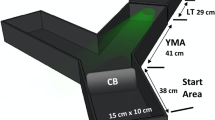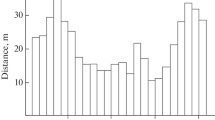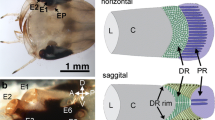Synopsis
Retinomotor movements of three size classes of juvenile French grunts, Haemulon flavolineatum, are characterized during the periods of their daily evening and dawn migration. Differences in the extension and withdrawal of the cones correlate with the earlier departure and later return to the daytime schooling sites of the smallest juveniles as compared to the larger juveniles. For each size class changes in the dimensions and retinal distribution of the cone cells and optical properties of the eye are used to estimate differences in photosensitivity under conditions of equal radiant intensities. For a target subtending any given angle, calculation indicates that the largest juveniles should be capable of discrimination at one-thousandth the light intensity of the smallest juveniles. The differences in potential photosensitivity correlate with the different intensities at which they migrate. The likely trigger to initiate their daily migrations probably involves circadian factors at dawn and extension of the single cones from the focal region of the retina prior to the evening migration.
Similar content being viewed by others
References cited
Ali, M.A. 1975. Retinomotor responses. pp. 313–355. In: M.A. Ali(ed.) Vision in Fishes, Plenum Press, New York.
Ali, M.A. & M. Anctil. 1976. Retinas of fishes. Springer Verlag, Berlin. 284 pp.
Ali, M.A., W.R. Stevenson & J.S. Press. 1961. Histophysiological studies on the juvenile Atlantic salmon (Salmo salar) retina. I. Rates of light and dark adaptation. Can. J. Zool. 391: 123–128.
Brothers, E.V. & W.N. McFarland. 1981. Correlations between otolith microstructure, growth, and life history transitions in newly recruited French grunts (Haemulon flavolineatum) (Desmarest), Haemulidae). Rapp. Cons. Explor. Mer 178: 369–374.
Burnside, B. & B. Nagle. 1983. Retinomotor movements of photoreceptors and retinal pigment epithelium: mechanisms and regulation. Progr. Retinal Res. 2: 67–109.
Cameron, N. 1982. The photopic spectral sensitivity of a dichromatic teleost fish (Perca fluviatilis). Vision Res. 22: 1341–1348.
Crescitelli, F. 1991. Adaptations of visual pigments to the photic environment of the deep sea. J. Exp. Zool. Suppl. 5: 66–75.
Douglas, R.H. 1982a. The function of the photomechanical movements in the retina of rainbow trout (Salmo gairdneri). J. Exp. Biol. 96: 389–403.
Douglas, R.H. 1982b. An endogenous crepuscular rhythm of rainbow trout (Salmo gairdneri): photomechanical movements. J. Exp. Biol. 96: 377–388.
Douglas, R.H. & M. Djamgoz(ed.). 1990. The visual system of fish. Chapman & Hall, London. 526 pp.
Douglas, R. & H.J. Wagner. 1982. Endogenous patterns of photomechanical movements in teleosts and their relation to activity rhythms. Cell Tiss. Res. 226: 133–144.
Endler, J. 1991. Variation in the appearance of guppy color patterns to guppies and their predators under different visual conditions. Vision Res. 31: 587–608.
Geusz, M. & T. Page. 1991. An opsin-based photopigment mediates phase shifts of the Bulla circadian pacemaker. J. Comp. Physiol. 168A: 565–570.
Hairston, N., K. Li & S. Easter, Jr. 1992. Fish vision and detection of planktonic prey. Science 218: 1240–1242.
Helfman, G. 1986. Fish behavior by day, night, and twilight. pp. 366–387. In: T.J. Pitcher(ed.) The Behavior of Teleost Fishes, Croom-Helm, London.
Helfman, G., J. Meyer & W.N. McFarland. 1982. The ontogeny of twilight migration patterns in grunts (Pisces: Haemulidae). Anim. Behav. 30: 317–326.
Hobson, E. 1965. Diurnal-nocturnal activity of some inshore fishes in the gulf of California. Copeia 1965: 291–302.
Hobson, E. 1972. Activity of Hawaiian reef fishes during the evening and morning transitions between daylight and darkness. U.S. Fish. Bull. 70: 715–740.
Hobson, E. 1973. Diel feeding migrations in tropical reef fishes. Helgolander Meeresunter. 24: 361–370.
Hobson, E., W.N. McFarland & J.R. Chess. 1981. Crepuscular and nocturnal activities of Californian nearshore fishes, with consideration of their scotopic visual pigments and the photic environment. U.S. Fish. Bull. 79: 1–30.
Hueter, R.E. & J. Cohen (ed.).1991. Vision in elasmobranchs: a comparative and ecological perspective. (Symposium 1990, Sarasota, Florida). J. Exp. Zool. Suppl. 5. 182 pp.
Kennedy, D. & R.H. Milkman. 1956. Selective light absorption by the lenses of lower vertebrates and its influence on spectral sensitivity. Biol. Bull. 111: 375–386.
Loew, E.R. & W.N. McFarland. 1990. The underwater visual environment. pp. 1–43. In: R. Douglas & M. Djamgoz(ed.) The Visual System of Fish, Chapman and Hall, London.
Lythgoe, J.N. 1979. The ecology of vision. Clarendon Press. Oxford. 244 pp.
Major, P.F. 1977. Predator-prey interactions in schooling fishes during periods of twilight: a study of the silverside Pranesus insularum in Hawaii. U.S. Fish. Bull. 75: 415–426.
McFarland, W.N. 1991. The visual world of coral reef fishes. pp. 16–38. In: P. Sale(ed.) The Ecology of Fishes of Coral Reefs, Academic Press, New York.
McFarland, W.N. & Z.M. Hillis. 1982. Observations on agonistic behavior between members of juvenile French and white grunts — Family Haemulidae. Bull. Mar. Sci. 32: 255–268.
McFarland, W.N. & N. Kotchian. 1982. Interaction between schools of fish and mysids. Behav. Ecol. Sociobiol. 11: 71–76.
McFarland, W.N. & F.W. Munz. 1975. The visible spectrum during twilight and its implications to vision. pp. 249–370. In: G.C. Evans, R. Bainbridge & O. Rackham(ed.) Light as an Ecological Factor: II, The 16th Symposium of the British Ecological Society, Blackwell Scientific Publ., Oxford.
McFarland, W.N., J.C. Ogden & J.N. Lythgoe. 1979. The influence of light on the twilight migrations of grunts. Env. Biol. Fish. 4: 9–22.
Mueller, H. 1954. Die Dunkeladaptation beim Guppy (Lebistes reticulatus P). Z. Vergl. Physiol. 37: 1–18.
Munz, F.W. & W.N. McFarland. 1973. The significance of spectral position in the rhodopsins of tropical marine fishes. Vision Res. 13: 1829–1874.
Munz, F.W. & W.N. McFarland. 1977. Evolutionary adaptations of fishes to the photic environment. pp. 193–274. In: F. Crescitelli (ed.) The Handbook of Sensory Physiology, Vol. V/7, Springer-Verlag, Berlin.
Nuboer, J.F.W. 1971. Spectral discrimination in a rabbit. Documenta Ophthalmologica 30: 279–298.
Nuboer, J.F.W., W.M. van Nuys & J.C. van Steenbergen. 1983. Color changes in a light regimen as synchronizers of circadian activity. J. Comp. Physiol. 151A: 359–366.
Ogden, J.C. & P. Ehrlich. 1977. The behavior of heterotypic resting schools of juvenile grunts (Pomadasyidae). Mar. Biol. 42: 273–280.
Otten, E. 1981. Vision during growth of a generalized Haplochromis species, H. elegans. Netherland J. Zool. 31: 650–700.
Seliger, H.H. & W.G. Fastie. 1968. Studies at Oyster Bay in Jamaica, West Indies. Measurements of underwater-sunlight spectra. J. Mar. Res. 26: 273–280.
Snyder, A.W. 1975. Photoreceptor optics-theoretical principles. pp. 38–55. In: A.W. Snyder & R. Menzel(ed.) Photoreceptor Optics, Springer-Verlag, Berlin.
Snyder, A.W 1979. The physics of vision in compound eyes. pp. 225–314. In: H. Autrum (ed.) The Handbook of Sensory Physiology, Vol. VII/6A, Springer-Verlag, Berlin.
Tamura, T. & W.J. Wisby. 1963. The visual sense of pelagic fishes, especially the visual axis and accommodation. Bull. Mar. Sci. 13: 433–448.
Wahl, C.M. 1991. Ontogeny of the retina in two species of percid, the yellow perch Perca flavescens, and the walleye, Stizostedion vitreum. Ph.D. Dissertation, Cornell University, Ithaca. 182 pp.
Wahl, C.M., E.L. Mills, W.N. McFarland & J. DeGisi. 1993. Ontogeny of visual acuity in the yellow perch, Perca flavescens. Can. J. Fish. Aquat. Sci. 50: 743–749.
Winston, R. & J.M. Enoch. 1971. Retinal cone receptor as an ideal light collector. J. Opt. Soc. Am. 61: 1120–1121.
Welford, W.T. & R. Winston. 1989. High collection nonimaging optics. Academic Press, San Diego. 284 pp.
Author information
Authors and Affiliations
Additional information
This paper is dedicated to the memory of John Lythgoe, whose insight served as inspiration for this study.
Rights and permissions
About this article
Cite this article
McFarland, W.N., Wahl, C.M. Visual constraints on migration behavior of juvenile French grunts. Environ Biol Fish 46, 109–122 (1996). https://doi.org/10.1007/BF00005213
Received:
Accepted:
Issue Date:
DOI: https://doi.org/10.1007/BF00005213




